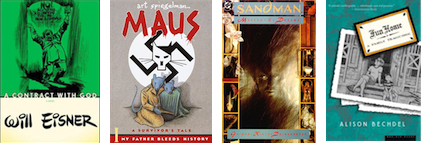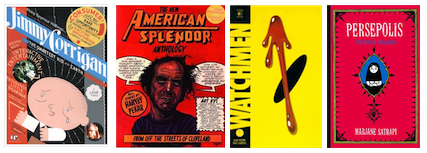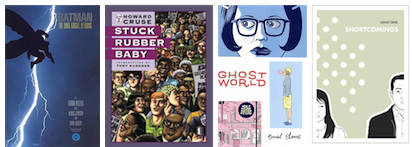Overview
This semester, I’m working on a proposal for a new course: “Development of the Graphic Novel.” It’s a variation of one of our existing genre courses called “Development of the Novel,” which I’ve taught once here and twice at another school. If it’s approved, I probably won’t be teaching this new course for at least another year, which gives me a good chunk of time to prepare.

And even though the genre of the novel is associated with fiction—while the genres of journalism, memoir, biography, or autobiography are associated with non-fiction—this course should allow for the inclusion of works that aren’t, strictly speaking, fiction. Nevertheless, I think it makes more sense to stick to a term like “graphic novel” than to adopt a more awkward possibility like “visual storytelling” or “sequential art.”
Well-known names in the fiction category of graphic novels include Daniel Clowes, Will Eisner, Neil Gaiman, Frank Miller, Alan Moore, and Adrian Tomine and Chris Ware. (Hmmm… my fiction list needs some women. Feel free to make suggestions in the comments below.)
And the following names are among those well-known for non-fiction: Alison Bechdel, Howard Cruse, Harvey Pekar, Joe Sacco, Marjane Satrapi, and—perhaps most famously, due to the success of Maus— Art Spiegelman,
Rationale: There are 2 good reasons why we should add this course to our catalog:
- The importance of the genre: Regardless of whether you believe that graphic novels are the contemporary equivalent of, say, Renaissance drama in terms of literary merit, they are a vibrant and growing genre. And many graphic novelists have published or are publishing in no less a literary periodical than the New Yorker. An English degree program that fails to introduce students to this genre is not doing its job.
- The need for visual literacy: English majors need to have the skills—and be introduced to the tools—for critical visual analysis, and studying graphic novels is an ideal way to fulfill that goal. Careers in the publishing industry require visual literacy for such tasks as page layouts, cover designs, and marketing. Careers in web-based work also require visual literacy in order to create web sites that are attractive, easy to understand, and easy to navigate. An English degree program that fails to help students acquire this essential characteristic is not doing its job. (I’m planning a future post on the ways in which we can do a better job of preparing students for careers working in digital media. Stay tuned…)
Request for Input
First, those of you who are knowledgeable—either as fans or as scholars—can help out by sharing what you think some of the foundational primary works are in the genre as well as some of the most exciting recent works.

Second, those of you who are knowledgeable as scholars on the subject can help out by sharing what you think some of the foundational secondary works are as well as who the current important voices are in the scholarship on the subject. There’s a great deal to choose from.
Course Description
Course Topic: English 3??: Development of the Graphic Novel
Course Summary: A critical and historical study of the graphic novel surveying major works and artists and illustrating the characteristics of the genre, its historical development, and its reflection of significant literary periods and movements.

Objectives: Upon completion of this independent study, the student will
- have an understanding of the history and continuing evolution of this genre;
- be able to read critically texts that combine the visual with the linguistic; and
- be familiar with the body of secondary material concerning the genre.
Method of Evaluation
- Weekly, substantive entries in an online discussion forum, open to a select group of outside readers who may or may not provide feedback. These entries will be composed not only of words—essay-writing being a skill that students in English courses should expect to use and strengthen—but also of images from the works in question, annotated using a simple tool like Jing. Examples of such annotation—not currently featuring pages from graphic novles—may be viewed by clicking here.
- Annotated bibliography 1, covering 5 article-length scholarly works.
- Midterm paper, 4 to 6 pages.
- Annotated bibliography 2, covering 5 article-length scholarly works.
- Final paper, 8 to 12 pages.
- Collaborative research presentations that must use visual aids effectively. (Inspired by Jason B. Jones and my own experience as a Talk 20 speaker at HUB-BUB, I’m considering having students do them as Pecha Kucha presentations. Trust me: it’s pretty cool.)
Hypothetical Reading List
Primary works:
- Will Eisner, A Contract with God
- Harvey Pekar, American Splendor
- Alan Moore, Watchmen
- Frank Miller, The Dark Knight Returns
- Art Spiegelman, Maus
- Chris Ware, Jimmy Corrigan, the Smartest Kid on Earth
- Marjane Satrapi, Persepolis
- Alison Bechdel, Fun Home
- Would you include something else here…?
Secondary works:
- Will Eisner, Graphic Storytelling and Visual Narrative
- Scott McCloud, Understanding Comics
- What else…?
Bonus!
Scott McCloud, “Understanding Comics” (17:08)
From TED.com, posted in January 2009.
Blurb from the YouTube page (a little over-the-top, if you ask me): “In this unmissable look at the magic of comics, Scott McCloud bends the presentation format into a cartoon-like experience, where colorful diversions whiz through childhood fascinations and imagined futures that our eyes can hear and touch.”
See also the TED “speakers page” on Scott McCloud, which links to related material by and about him.


I’m in the minority by far on this, I know, but I don’t like to use the term “novel” because it has particular connotations to me that are different from memoir. Last fall, I taught a course on The Graphic Memoir. Following Judith Barrington, I believe that those who create novels and those who create memoirs are making different kinds of contracts with readers, and the genre label is important so that there is less confusion about such expectations. But I know I’m in the minority on this.
If you do want to see my course blog for that class, it’s here:
http://fys100fall2008.blogspot.com/
Fair enough, Nels (and thanks for the link to your course blog!).
I have two different responses, and since the second response will take longer than I have time for right now, I’ll save it for later.
Response #1: If I want to include both fiction and non-fiction (even as I want to problematize the neat division of those labels), what should I call the course?
I would call the course The Development of Graphic Literature. When we developed Gay and Lesbian Literature as a permanent course, we used “Literature” because it allowed us to teach fiction, poetry, drama, and nonfiction (in all its forms).
Also, remember what I said above about me being in the minority. When I have made this point about genre in various contexts, I have always been ignored or told “Graphic Novel is a basic umbrella term,” meaning, “Dude, get over it.” In fact, you’re the first person to acknowledge what I said and engage with it, so thanks!
But remember that I do not have a background in literature, and that might affect my perspective. In rhetoric, one of the first questions we ask about anything centers on genre because genre shapes how we respond to it. Also, having taken classes in eight different departments throughout my graduate career (including architecture!), I learned quickly to stop and ask myself questions about genre before I did the basic work for any class. Genre is a big deal to me, but I understand that it’s not for a lot of people.
I’m also in the middle of a big project on truth in memoir, and I believe that those who create memoirs often have different goals than those who create fiction, and those goals can shape our reading practices, which is another reason why genre plays a huge role in my classes.
Have you read Blankets? It is a BEAUTIFUL graphic novel and the one I give to convince people that the genre is more than capes and cowls.
About Watchmen and The Dark Knight Returns, I think that they have more of an impact if people are familiar with more traditional superhero stories of that time. To show why those books were so important and how they changed the game.
Also, and interesting take would be a discussion about how monthly comic issues (“floppies”) are being written a certain way now so they can neatly be tied into a trade paper back. So the success of Graphic Novels/Trade Paper Backs has affected the way the entire comic industry works. Since floppies aren’t really found outside of comic book shops anymore (even bigger discussion) so many people’s first encounter with the medium is now Graphic Novels and as more and more of them are about things other than people in tights it will change how people see that form of story telling.
I love, love, love Blankets. In my Graphic Memoir course, it became my favorite, at least in terms of emotional impact. I liked Fun Home on an intellectual level. It had me thinking for days. But Blankets was much more emotional for me, and it was the images that did it.
How about “The Development of Graphic Design in Novels and Nonfiction: New Forms Of Storytelling” ?
I think that, to the general public, the term “graphic novel” may be the most immediately understood, but it wouldn’t cover the course as you’ve proposed it. Do you have to include the phrase “The Development of. . .” in your title? That seems most constraining to me, as I see it as a merging of two (or more)genres.
Here’s what I’d do: I’d ask Billie Hara. Honest.
I’m taking the liberty of adding some screenshots of Tweets about this post.
The Miracle Man tweet is a good suggestion. It had a lot of the major writers in the industry work on it before they were famous. It is hard to find though. Marvel just got the rights to it and hopefully that means reprints.
Would something like graphic literature or graphic narrative texts work as an alternative to the graphic novel? By the way, I may borrow what you’ve done to propose a similar course at FSU.
George, This looks really good and I especially appreciate your rationale for why this is an important course for majors. I don’t think I have much to add at the moment to what you are talking about except for the secondary works that I gleaned from various people on Twitter, including @samplereality, @retius, and @zachwhalen, as well as a friend at Emory.
Hillary Chute. “Comics as Literature? Reading Graphic Narrative.” PMLA 123.2: 452-465.
Response to this article in the forum of PMLA 124.1: 292-295.
The whole issue of Modern Fiction Studies 52.4.
The whole issue of English Language Notes 46.2.
Scott McCloud, Understanding Comics
Scott McCloud, Making Comics
Douglas Wolk, Reading Comics: How Graphic Novels Work and What They Mean
Will Eisner, Comics and Sequential Art
Thierry Groensteen, The System of Comics
Jessica Abel and Matt Madden, Drawing Words & Writing Pictures
1. Why Pekar and not Crumb?
2. Including both Watchmen and Dark Knight Returns seems like overkill, in the sense that they’re both trying to reboot the genre of the superhero as a whole . . . but you don’t have any examples of what they’re reacting against! So I’d think about having one of these books, plus a more traditional underwear perverts book.
3. Alex is right, probably Warren Ellis.
4. You could even think about a work like Snow Crash, which was first conceived as a graphic novel, as a way to think about the way those conventions remain in the final text. (Could do something similar w/The Matrix.)
5. In general, I would say that the course as proposed is too presentist in its orientation, but I’m not sure of a good way to fix that–I haven’t looked into what’s available.
Do you know Guibert’s *The Photographer: Into War-torn Afghanistan with Doctors Without Borders*? Fabulous memoir that mixes text with illustration with photographs. Simply a stunning work. Made me wish I was still teaching…
George,
I’m coming late to the party, but I’m in the middle of doing a Graphic Novels course now for our First-Year Experience course (an interest-driven mandatory 1-credit course for first-year students which is yoked to an extended orientation course).
My only suggestion would be to move the McCloud to the primary reading list, and to start the semester with it. It immediately sets the tone that what we’re pursuing here is something academic, something that has a lot of thought behind it, and not merely a weekly get-together where we ask one another “how cool was that text?”
I have two sections of this, and they’re both incredibly engaged by the McCloud, especially those who are way into graphic fiction. It’s articulating a lot of what they grasped intuitively, and it’s giving them a vocabulary that we can use for the rest of the semester.
BTW, the Eisner, Moore, Spiegelman, Ware, and Satrapi were all on my proposed reading list for the 3-credit version of this course, as well as Blankets and a couple of other texts that are escaping me right now. Since we’re in the middle of transitioning to a new curriculum, I won’t be offering it until next year at the earliest.